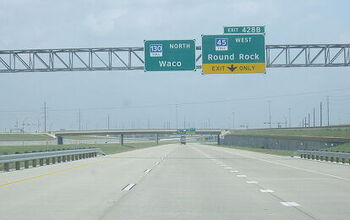Texas Moves to Eliminate Nighttime Speed Limits, Raise Speeds
Texas is the last state in the nation that still imposes different speed limits on its highways depending on whether it is daytime or nighttime. Roads marked 70 MPH during the day can only be legally driven at 65 MPH when its dark. Big rig trucks must also obey specially lowered speed limits. The state House Transportation Committee yesterday filed a favorable report on legislation that would simplify the Lone Star State’s speed laws and boost the speed limit in most rural areas.
“A difference in vehicle speeds can contribute to accidents,” the House committee report explained. “HB 1353 seeks to minimize the number of accidents that can occur when cars and trucks change lanes or pass or tailgate slower-moving vehicles by removing the different, lower speed limit for heavy trucks.”
Instead of a 70 MPH daytime and 65 MPH nighttime maximum speed on rural highways, the default speed limit in all conditions will be 75 MPH. The change would apply to interstate highways, state freeways, farm-to-market and ranch-to-market roads. Only school buses would be forced to adhere to specially lowered limits. The National Motorists Association argues that, contrary to what some might argue, the change will make the roads less dangerous.
“Having split speed limits between cars and trucks sharing the same roadways is poor traffic safety design,” NMA Executive Director Gary Biller the told TheNewspaper. “The same is true for variable daytime/nighttime speed limits. Anything that has the potential for adding driver confusion or uncertainty is inadvisable.”
The Texas Department of Transportation (TxDOT) along with the Utah Department of Transportation, post the fastest legal speed limits of 80 MPH on certain roads. Utah has reported an excellent safety record for its 80 MPH stretch of Interstate 15. Likewise, Texas last year reported a record drop in accidents statewide, with the high-speed roads showing excellent results. After five years of testing, TxDOT also found the 75 MPH limits appropriate for roads outside the urban environment.
“Crash records show that when the speed limit in these areas increased to 75 MPH in 2001, the number of traffic deaths on those segments decreased,” said Carlos Lopez, TxDOT Traffic Operations Division director, in a 2006 department explanation of speed limit changes in West Texas. “Motorists can prevent crashes by practicing safe driving habits.”
If adopted by the full House and Senate, the measure would take effect in September. A copy of the legislation is available in a 53k PDF file at the source link below.
House Bill 1353 (Texas Legislature, 3/30/2011)
[Courtesy: Thenewspaper.com]
More by The Newspaper
Latest Car Reviews
Read moreLatest Product Reviews
Read moreRecent Comments
- TheEndlessEnigma My 2016 FiST has been the most reliable car I've owned.
- MaintenanceCosts I already set out total costs, so this time I'll list what's had to be done on my cars (not counting oil changes, recall, or free services):2019 Bolt (25k mi): new 12v battery, pending tires & battery cooling service2016 Highlander (from 43k to 69k mi): new front rotors, new pads all around, new PCV valve, 2x 12v batteries, light bulbs, pending tires2011 335i (from 89k to 91k): new valve cover gasket, new spark plugs, light bulbs, pending rear main seal1995 Legend (from 185k to 203k): timing belt/water pump, new EGR valve + pipe, struts, strut bushings, drive axles, tie rods, rear control arms, other suspension bushings, coolant hose & brake lines throughout, belts, radiator, valve cover gaskets, new power antenna, 12v battery, coils, spark plugs, tires, rear pads... it's an old car!
- VoGhost Consistent with CR's data. I've spent about $150 total on the Model 3 in six years of ownership, outside of tires.
- VoGhost It's just plain sad that Posky doesn't know that EV batteries are warrantied for 8 years / 100K miles.
- Jkross22 It used to be depreciation was the most expensive part of car ownership. Seems like those days are over (New EVs and lux cars excluded). Maintenance + insurance have taken over. Dealerships offering 2 years of maintenance means nothing. That's $200 tops. It's the unexpected repairs - a wiring harness, computer module, heater core, AWD problems - that will cost dearly. Brakes can be expensive since many cars now can't have rotors resurfaced. Even independents are charging a lot for this work.


































Comments
Join the conversation
Some roads I can see that, but most of the FM roads I've driven, even at 65, they are pretty darn entertaining enough to keep me focused.
Wonderful news! Next step -- get rid of the laughably ridiculous speed trap along the .6-mile length of US Highway 287 that runs through Estelline.